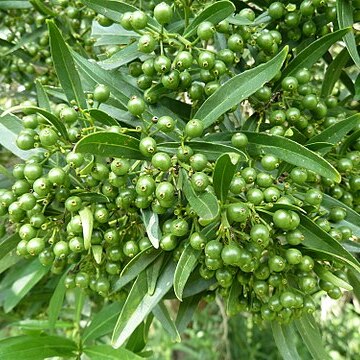Much-branched small tree to 3.5 m. Stem Single-stemmed. Bark light grey, finely fissured. Leaves opposite, lanceolate, 50-90 x 9-20 mm, taper to apex & base, thin to leathery, shiny or dull, dark green, smooth, domatia in vein axils, scattered nodules in blade, 3-5 pairs of veins. Stalk short, 2-6 mm. Flowers white, corolla tube 5-7 mm, calyx teeth 0.2-0.5 mm, pointed. In large clusters with long stalks, toward branchlet ends. Fruits black, ± round, to 7 mm diam., short, persistent calyx at tip. In dense clusters.
Leaves subsessile to shortly petiolate; blades 3–8.5(15) × (0.4)0.6–2(2.4) cm, narrowly elliptic or linear-elliptic, acute or obtuse at apex, narrowly cuneate at base, subcoriaceous, often blackening when dry, dull or less often shiny, often with the margins revolute; lateral nerves in c. 4 main pairs; domatia present as ciliate pits; bacterial nodules dot-like or sometimes elliptical, scattered; petioles up to 2.5(4) cm long; stipule limbs 1–1.4 mm long, truncate, becoming scarious; arista 1.5–2.2(3.5) mm long.
A shrub or medium sized tree. The trunk can be 23 cm across. The leaves are opposite and simple. They are slender and 3.8-11 cm long. They are narrowed at both ends. The leaves are pointed and shiny above and dull beneath. The edges of the leaves are often rolled inwards. The flowers are large and tubular. The tube is 1.9 cm long. The fruit are small and round. They are pea sized and black. The leaves of the form known as Pavetta tristis are edible.
Inflorescences corymbiform, 1.5–5.5 cm across (excluding corollas), often composed of main corymb with 1–2 subsidiary lateral corymbs, each subtended by paired leaves, often nodes on inflorescence rhachis also bear reduced leaves; inflorescence branches clearly present; pedicels 3–4 mm long; bracts stipule-like; bracteoles stipule-like, limb c. 2 mm long.
Small tree or shrub, up to 3.5 m high. Leaves narrowly elliptic, subsessile, petiole 2-6 mm long, glabrous, bacterial nodules dot-shaped and scattered. Calyx lobes 0.2-0.5 mm long. Corolla tube 5-7 mm long. Flowers white.
Glabrous shrub or small tree, 1–5 m tall; young twigs slender glabrous, very rarely puberulous, becoming covered with whitish-fawn or whitish-grey bark with maturity.
Corolla white, glabrous outside; tube 4–7(8) mm long, 0.8–1 mm wide at the top, not bearded at the throat; lobes 4–7 × 1.5–2.5 mm oblong, obtuse.
Calyx tube 0.6–0.8 mm long; limb 1–1.3 mm long, wider than tube, repand to undulate or producing shortly triangular, often apiculate, lobes.
Inflorescence-supporting branches 1.5–5.5 cm long, with (0)1–6(8) leaf-bearing nodes tending to cluster towards apex.
Fruit black 4–5 mm in diameter, crowned by calyx limb.


